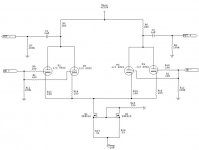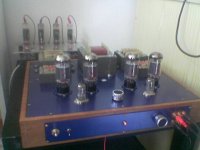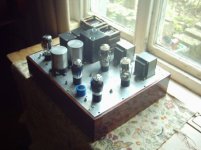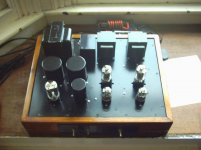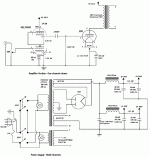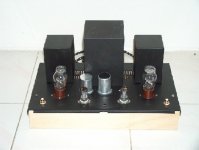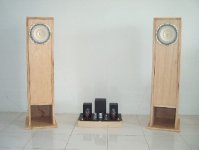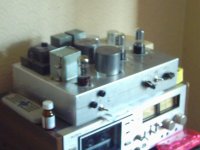rdf said:Hey leadbelly, how do you change the volume? Is the circuit balanced?
🙂 I purposely left the knob off; it'll be built into a separate enclosure. More real estate taken up but easier to tweak the chain. Right now I'm just using a messy RCA-pot-XLR cable as a control.
Yes, it's balanced. It's essentially this:
http://home.c2i.net/semfielec/tubepre.htm
Attachments
Here comes some pics of my tube amps.
An externally hosted image should be here but it was not working when we last tested it.
An externally hosted image should be here but it was not working when we last tested it.
An externally hosted image should be here but it was not working when we last tested it.
Re: Here is mine!
Spectacular!
Anthony
ackcheng said:
Spectacular!
Anthony
Re: My first love!
Very Nice,
My tube projects are still on the go, nothing to post yet really.
Antrhony
kathodyne said:annastacia 20w push-pull class a, longtail pahase splitter with constant current source
and... py500 tube-supply
Very Nice,
My tube projects are still on the go, nothing to post yet really.
Antrhony
thanx y'all
'Anna' was my first project, first out of stainless steel, but her dimensions were way too big, this second (blue) version is of aluminium which i've just sprayed with blue (little bit metallic) car paint.
Gives quite a nice result!!
The biggest improvement is the new way of mounting the transformers, now with the connections down....much safer than letting the transformers been stroked by children!!! bzzzzz!!!
It's my first amp 😎
'Anna' was my first project, first out of stainless steel, but her dimensions were way too big, this second (blue) version is of aluminium which i've just sprayed with blue (little bit metallic) car paint.
Gives quite a nice result!!
The biggest improvement is the new way of mounting the transformers, now with the connections down....much safer than letting the transformers been stroked by children!!! bzzzzz!!!
It's my first amp 😎
Hi kathodyne,
Quite amazing for a first amp! Dick did not use the PY500 supply...but I think that is a real good touch of personal modification you did there...!!
What convinced you to go the damper diode way?
Cheers,
Bas
Quite amazing for a first amp! Dick did not use the PY500 supply...but I think that is a real good touch of personal modification you did there...!!
What convinced you to go the damper diode way?
Cheers,
Bas
Hee bas,
Yes, Dick did uses the py500 suply in his 211 amp.(he also designed Anna)
i thought of them after asking questions about tubes in my power-supply (i really wanted mercury-rectifiers )
)
Because i had a lot of capacitance behind the SSdiodes (150uf-10H-150uf-3k3-68uf) and there was too much current (138ma) they told me it was not possible to use tube-rectifiers.
Then i saw the diodes and thought...'well if it can drive a 211, it can drive some little 7027a)
Now i know that probably it could 've been done with maybe a gz34, i had to change the capacitors anyhow, even with the py500A
now it is (40uf-10h-300uf-3k3-82uf)
Yes, Dick did uses the py500 suply in his 211 amp.(he also designed Anna)
i thought of them after asking questions about tubes in my power-supply (i really wanted mercury-rectifiers
 )
)Because i had a lot of capacitance behind the SSdiodes (150uf-10H-150uf-3k3-68uf) and there was too much current (138ma) they told me it was not possible to use tube-rectifiers.
Then i saw the diodes and thought...'well if it can drive a 211, it can drive some little 7027a)
Now i know that probably it could 've been done with maybe a gz34, i had to change the capacitors anyhow, even with the py500A
now it is (40uf-10h-300uf-3k3-82uf)
My direct-coupled 2A3
As you can see this is the prototype with Parmeko c-core trannies.The big black one is the 2x2.5v and 12.6vct military tranny I use for the filaments of the 2A3's and 5Z3 rectifier.The small parmeko heats the 6N7 input valves and Psu caps are GE oil-filled.50uF each and 2 10H chokes for the split rail HT supply.The amp circuit comprises of 2 caps and 6 resistors.
As you can see this is the prototype with Parmeko c-core trannies.The big black one is the 2x2.5v and 12.6vct military tranny I use for the filaments of the 2A3's and 5Z3 rectifier.The small parmeko heats the 6N7 input valves and Psu caps are GE oil-filled.50uF each and 2 10H chokes for the split rail HT supply.The amp circuit comprises of 2 caps and 6 resistors.
Attachments
SE 2A3 direct coupled
I'll post a schematic as soon as I've scanned it.in the mean time I'll do a description.Aim for 380-400v B+.From the opt to the anode of the output valve is straightforward,here's the interesting bit....connect both cathodes of op valves to a r which is double the value for one tube ie:2A3=1K5 50watts or so.Bypass it with 80uF at 400v.the -ve end is connected to BOTH cathodes of the PARALLEL 6N7's .On the 2A3 there are also 4k7 resistors between the cathodes of the 2A3's and the anodes of the 6N7's.The anode of the 6N7 is also connected to the grid of the 2A3 via a 10k gridstopper.Finally,between the cathodes of the 6N7's and ground(busbar) use a 100ohm(2W) variable resistor up to bypassed with a 4700uF 50v cap.Adjust the VR to get a voltage drop of 150v across the 1k5 resistor above it.Simple!!I also use 50ohm humpots for the 2A3 filaments with a busbar between the middle lugs and a busbar to connect the cathodes of the 6N7's together.Makes it all easier.Hardly any soldering involved.The PSU is the one Raymond Koonce used for his 2A3 amp minus the 1.2k resistors and with a hT secondary of 380-0-380 at 240mA but 150mA should be enough.The whole lot draws about 140mA
I'll post a schematic as soon as I've scanned it.in the mean time I'll do a description.Aim for 380-400v B+.From the opt to the anode of the output valve is straightforward,here's the interesting bit....connect both cathodes of op valves to a r which is double the value for one tube ie:2A3=1K5 50watts or so.Bypass it with 80uF at 400v.the -ve end is connected to BOTH cathodes of the PARALLEL 6N7's .On the 2A3 there are also 4k7 resistors between the cathodes of the 2A3's and the anodes of the 6N7's.The anode of the 6N7 is also connected to the grid of the 2A3 via a 10k gridstopper.Finally,between the cathodes of the 6N7's and ground(busbar) use a 100ohm(2W) variable resistor up to bypassed with a 4700uF 50v cap.Adjust the VR to get a voltage drop of 150v across the 1k5 resistor above it.Simple!!I also use 50ohm humpots for the 2A3 filaments with a busbar between the middle lugs and a busbar to connect the cathodes of the 6N7's together.Makes it all easier.Hardly any soldering involved.The PSU is the one Raymond Koonce used for his 2A3 amp minus the 1.2k resistors and with a hT secondary of 380-0-380 at 240mA but 150mA should be enough.The whole lot draws about 140mA
Attachments
Raymond Konce 2A3 scematic
http://www.timebanditaudio.com/2a3/schematic.html
Here's a better schematic,more detailed
http://www.timebanditaudio.com/2a3/schematic.html
Here's a better schematic,more detailed
Proudly displayed with my new Coral 6B in a TQWT enclosure.
This speaker has very good clarity and forward soundstage as found in many japanese speakers. Bass is lacking, but music is so good that its not really noticed. Contrary to some peoples comments, I dont detect loss in treble compared to fostex drivers.
I will have to tweak the darling further to reduce the 'thick' vocals. Its like having too much sugar...
This speaker has very good clarity and forward soundstage as found in many japanese speakers. Bass is lacking, but music is so good that its not really noticed. Contrary to some peoples comments, I dont detect loss in treble compared to fostex drivers.
I will have to tweak the darling further to reduce the 'thick' vocals. Its like having too much sugar...
Attachments
- Home
- Amplifiers
- Tubes / Valves
- Photo Gallery
